Web Infantry Equipment, Pattern 1944
Equipment and Equipment Carriers: Other Carriers
Stores Ref. A6/AF 0259 Case, binocular, W.E. Patt. ‘44
Stores Ref. A1/AA 2004 Case, binocular, W.E. Patt. ‘44
Stores Ref. CN/AA 2004 Web Equipment Patt. ’44, Case, binocular
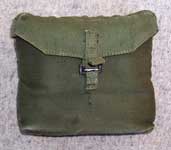
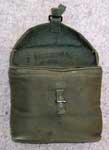
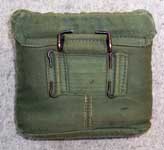
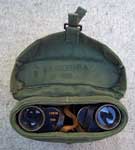 Intended for carriage of Binoculars, prismatic, No. 2, 7 x 30, this was a very neat, padded design, only stiffened in its base, with a hooded lid closed by a QR (Quick Release) fastener. The rear was fitted with both “C” clips and a hanger hook, which provided for direct attachment to the Belt, or to be slung below it. Correctly assembled to the Brace attachment, the hanger hook was connected to eyelets in the lower flange of the Compass pocket. The example shown here is maker marked "M.W. & S. Ltd." and dated 1945, and is from the David Gordon Collection. Photos © David Gordon 2009.
Intended for carriage of Binoculars, prismatic, No. 2, 7 x 30, this was a very neat, padded design, only stiffened in its base, with a hooded lid closed by a QR (Quick Release) fastener. The rear was fitted with both “C” clips and a hanger hook, which provided for direct attachment to the Belt, or to be slung below it. Correctly assembled to the Brace attachment, the hanger hook was connected to eyelets in the lower flange of the Compass pocket. The example shown here is maker marked "M.W. & S. Ltd." and dated 1945, and is from the David Gordon Collection. Photos © David Gordon 2009.
Stores Ref. A6/AF 0260 Case, pistol, W.E. Patt. ‘44
Stores Ref. A1/AA 2005 Case, pistol, W.E. Patt. ‘44
Stores Ref. CN/AA 2005 Web Equipment Patt. ’44, Case, pistol
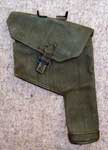

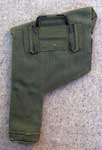
 Fitted at the rear, like the Binocular case, with hooks and a hanger, it attached to either Belt, or Pistol ammunition pouch and Brace attachment in the same way. Of Pattern 1937 W.E. form, for a .38-in. Pistol, revolver, No. 2, its flap was secured by a QR fastener. There were far less size variations than with Patt. ’37 Holsters. The example shown here is maker marked "M.E. Co." and dated 1945, and is from the David Gordon Collection. Photos © David Gordon 2009.
Fitted at the rear, like the Binocular case, with hooks and a hanger, it attached to either Belt, or Pistol ammunition pouch and Brace attachment in the same way. Of Pattern 1937 W.E. form, for a .38-in. Pistol, revolver, No. 2, its flap was secured by a QR fastener. There were far less size variations than with Patt. ’37 Holsters. The example shown here is maker marked "M.E. Co." and dated 1945, and is from the David Gordon Collection. Photos © David Gordon 2009.
Stores Ref. A6/AF 0261 Frog, bayonet, W.E. Patt. ‘44
Stores Ref. A1/AA 2006 Frog, bayonet, W.E. Patt. ‘44
Stores Ref. CN/AA 2006 Web Equipment Patt. ’44, Frog, bayonet

 This was of standard Patt. ’37 form, with its top scabbard loop having a woven eyelet from the outset. Provision for the Nos. 4 and 5 Scabbards, bayonet was made on the left hand Basic pouch, though they would also fit the eyelet of the Frog, which was otherwise intended to carry the No. 1 Bayonet for the S.M.L.E. The example shown here is maker marked "R.P." and dated 1945, and is from the David Gordon Collection. Photos © David Gordon 2009.
This was of standard Patt. ’37 form, with its top scabbard loop having a woven eyelet from the outset. Provision for the Nos. 4 and 5 Scabbards, bayonet was made on the left hand Basic pouch, though they would also fit the eyelet of the Frog, which was otherwise intended to carry the No. 1 Bayonet for the S.M.L.E. The example shown here is maker marked "R.P." and dated 1945, and is from the David Gordon Collection. Photos © David Gordon 2009.
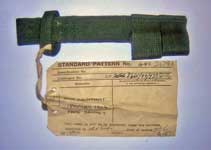
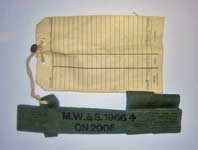 Shown left is a Sealed Pattern example of the Bayonet frog, maker marked "M.W. & S. Ltd." and dated 1965, from the Karkee Web Collection.
Shown left is a Sealed Pattern example of the Bayonet frog, maker marked "M.W. & S. Ltd." and dated 1965, from the Karkee Web Collection.
Stores Ref. A6/AF 0264 Pocket, compass, W.E. Patt. ‘44
Stores Ref. A1/AA 2009 Pocket, compass, W.E. Patt. ‘44
Stores Ref. CN/AA 2009 Web Equipment Patt. ’44, Pocket, compass
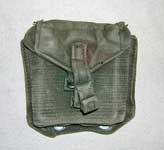

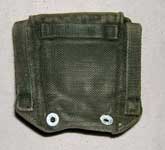
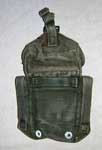
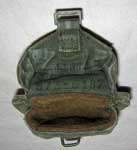 Similar to the Patt. ’37 type, the lower flange had two eyelets / grommets for attachment to the Binocular case. Borrowing directly from Web Equipment, Royal Artillery the rear face had belt loops, not “C” clips. The interior was padded and contained the standard prismatic compass. The box lid was closed by a QR fastener. A horizontal loop was fitted across the upper rear edge but, unlike Patt. ’37 assemblies, the Brace attachment simply passed through this loop, which retained the Pocket against the Attachment. This well-worn example, from the Karkee Web Collection, is maker marked "M.E. Co." and dated 1967.
Similar to the Patt. ’37 type, the lower flange had two eyelets / grommets for attachment to the Binocular case. Borrowing directly from Web Equipment, Royal Artillery the rear face had belt loops, not “C” clips. The interior was padded and contained the standard prismatic compass. The box lid was closed by a QR fastener. A horizontal loop was fitted across the upper rear edge but, unlike Patt. ’37 assemblies, the Brace attachment simply passed through this loop, which retained the Pocket against the Attachment. This well-worn example, from the Karkee Web Collection, is maker marked "M.E. Co." and dated 1967.
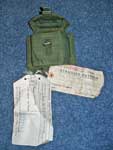 A Sealed Pattern example of the Compass pocket. From the Allen Prior Collection, it is maker marked "M.W. & S." and dated 1952. Photo © Allen Prior 2010.
A Sealed Pattern example of the Compass pocket. From the Allen Prior Collection, it is maker marked "M.W. & S." and dated 1952. Photo © Allen Prior 2010.
Stores Ref. A6/AF 0265, Pouch, ammunition, pistol, W.E. Patt. ‘44
Stores Ref. A1/AA 2010, Pouch, ammunition, pistol, W.E. Patt. ‘44
Stores Ref. CN/AA 2010 Web Equipment Patt. ’44, Pouch, ammunition, pistol
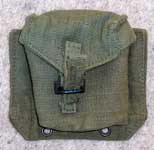
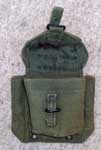
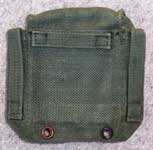
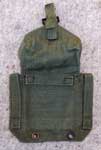
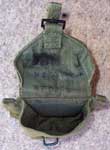 This was a repeat of the Compass pocket, but un-padded and intended to carry 12 rounds of .38-in. ammunition. This example is maker marked "M.E. Co." and dated 1945, and is from the David Gordon Collection. Photos © David Gordon 2009.
This was a repeat of the Compass pocket, but un-padded and intended to carry 12 rounds of .38-in. ammunition. This example is maker marked "M.E. Co." and dated 1945, and is from the David Gordon Collection. Photos © David Gordon 2009.
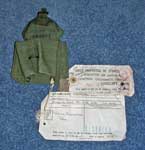 A Sealed Pattern example of the Pistol ammunition pouch. From the Allen Prior Collection, this pouch is maker marked "M.E. Co." and dated 1945. Photo © Allen Prior 2010.
A Sealed Pattern example of the Pistol ammunition pouch. From the Allen Prior Collection, this pouch is maker marked "M.E. Co." and dated 1945. Photo © Allen Prior 2010.
Stores Ref. Not applicable Pouch, “handy”, “W.E. Patt. ‘44”
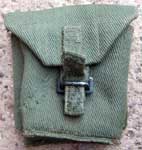

 No V.A.O.S. or C.O.S.A. has an entry for this item, which is included as a curiosity. Until a second example turns up, this is a “one off”, with a tongue-in-cheek, ascribed nomenclature! Quite what its precise purpose was, or even if it was converted after it became military surplus is not known.
No V.A.O.S. or C.O.S.A. has an entry for this item, which is included as a curiosity. Until a second example turns up, this is a “one off”, with a tongue-in-cheek, ascribed nomenclature! Quite what its precise purpose was, or even if it was converted after it became military surplus is not known.
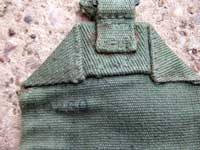 Looking much like the Pouch, ammunition, pistol, the number 0260 reveals the truth. Despite its dramatically changed appearance, it started out its life as a Case, pistol, W.E. Patt. ’44. Even without the code 0260 the orientation of the weave is diagonal, whereas it should run vertically and horizontally. Both elements of the holster’s Quick Release Fastener have been removed and re-attached, so their alignment to the weave is also incorrect.
Looking much like the Pouch, ammunition, pistol, the number 0260 reveals the truth. Despite its dramatically changed appearance, it started out its life as a Case, pistol, W.E. Patt. ’44. Even without the code 0260 the orientation of the weave is diagonal, whereas it should run vertically and horizontally. Both elements of the holster’s Quick Release Fastener have been removed and re-attached, so their alignment to the weave is also incorrect.
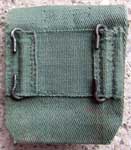 The “C” hook patch has also been removed & re-attached, with the same non-alignment. The back face and flap are a single piece of material.
The “C” hook patch has also been removed & re-attached, with the same non-alignment. The back face and flap are a single piece of material.
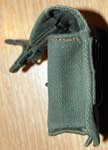

 It is not – strictly speaking - integrally woven, although the right-hand vertical edge is the integrally woven, ex-barrel side of the holster, with the holster body material carried across the front of the pouch. Both vertical sides have been newly stitched to give a rectangular cross-section, which leaves the left-hand edge with two “layers” showing and glued together.
It is not – strictly speaking - integrally woven, although the right-hand vertical edge is the integrally woven, ex-barrel side of the holster, with the holster body material carried across the front of the pouch. Both vertical sides have been newly stitched to give a rectangular cross-section, which leaves the left-hand edge with two “layers” showing and glued together.
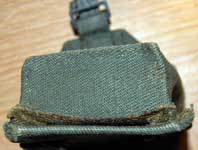 It lacks a “bellows” base, since it is a separate piece of webbing, double thickness and with a stiffener between the layers, to give a rigid, flat base. In side elevation this is folded 90 degrees and glued to the rear “flange” of material. This last is folded in on slight diagonals, resembling the usual profile of a ’44 Pocket / Pouch. Photographs (stone background) © Martin Clewlow, 2016 and “wood” background © R.J. Dennis 2016.
It lacks a “bellows” base, since it is a separate piece of webbing, double thickness and with a stiffener between the layers, to give a rigid, flat base. In side elevation this is folded 90 degrees and glued to the rear “flange” of material. This last is folded in on slight diagonals, resembling the usual profile of a ’44 Pocket / Pouch. Photographs (stone background) © Martin Clewlow, 2016 and “wood” background © R.J. Dennis 2016.